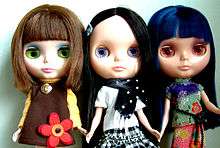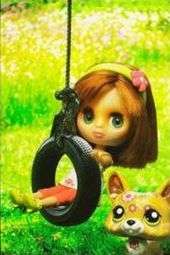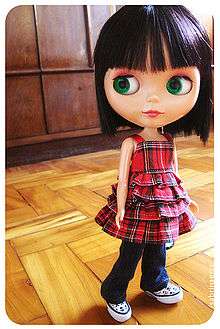Blythe (doll)
|
Blythe dolls can be customized | |
| Type | Fashion doll |
|---|---|
| Inventor | Allison Katzman |
| Company | Kenner/Takara[nb 1] |
| Country | USA/Japan |
| Availability | 1972–present |
| Official website | |
Blythe /ˈblaɪθ/ is a fashion doll, about 28 cm (11 inch) tall, with an oversized head and large eyes that change color with the pull of a string. It was created in 1972 and was initially only sold for one year in the United States by toy company Kenner (later purchased by Hasbro). In 2000 the photo book This is Blythe was published and in 2001 the Japanese toy company Takara[nb 1] began producing new editions of Blythe dolls. There is a network of hobbyists who customize the doll for resale and create clothing and shoes for Blythe. Enthusiasts share photographs of their work and other types of dolls on the Internet.[1]
History
Blythe was created in the early seventies by designer Allison Katzman at Marvin Glass and Associates[2] and bought and produced in the United States in 1972 by the now-defunct toy company Kenner. Many years ahead of her time, Blythe dolls were only sold for one year in the U.S. (produced in Hong Kong) and also in the UK, Australia and Japan, during 1972. Over time the original "Kenner" Blythe dolls acquired a cult following of collectors and eventually, photographers. Ms. Katzman stated at the August 1, 2014 Blythe panel discussion in Seattle, Washington that while designing a fashion doll to compete with Barbie, she considered elements girls would like to be able to have, such as changing eye color. (Which were partially inspired by her teenaged daughter's tinted contact lenses.) Ms Katzman has stated that she found Betty Boop to be her main inspiration, not the said Margaret Keane orphans, as some people have assumed. She created a mock up paper doll with sliding colored gels for eyes, that she presented to the other members of her creative team. Gordon Barlow, an in house engineer, then designed the distinctive rotating cylinder with four different eye colors, changed by way of a pull string in the back of Blythe's head.
In mid-1991, Hasbro purchased Tonka, which acquired Kenner Parker Toys, Inc. in 1987. Since then, all the intellectual properties are owned by Hasbro.
In 1997, New York TV and video producer Gina Garan was given a 1972 Kenner Blythe by a friend and began using it to practice her photographic skills. She began taking her Blythe everywhere with her and took hundreds of photos. In 1999, she was introduced to CWC's Junko Wong by artist and illustrator, Jeffrey Fulvimari who brought Blythe to the attention of Parco and toy executives. In 2000, Gina published her first book of Blythe photography with Chronicle Books, This is Blythe. In 2001, Hasbro (the current trademark and license owner) gave Takara[nb 1] of Japan and CWC a license to produce the New Edition of Blythe (Neo Blythe). Blythe was used in a television advertising campaign by Parco, the fashion branch of Seibu Department Stores in Japan and was an instant hit.
In 2003 Blythe was the subject in a segment on the VH1 special, I Love the '70s, where she was said to look like either "Barbie with elephantiasis" or "Christina Ricci" among other things. The success in Japan led Hasbro to issue a license to Ashton-Drake Galleries in 2004 to sell Blythe replica dolls in the United States, where the doll became a niche product in a marginal market, selling largely to adults. In spring 2009, Alexander McQueen launched a fashion line for Target with an ad campaign featuring Blythe dolls.[3] In 2010, Hasbro began releasing their version of Blythe as a part of the Littlest Pet Shop toy line.
Doll releases
There are three sizes of Blythe dolls: the original 28 cm (1/6 scale) full-sized dolls, the 11.2 cm "Petite Blythe" from Takara[nb 1] and the "Middie Blythe" of about 20 cm. Only full-sized dolls have color-changing eyes. The first Petite dolls were keychains, and after some time the design was changed so the Petite eyes would close when the doll was laid down. The Middie Blythes eyes can turn to the sides and her head can twist around. The dolls range in retail price from around US$60 for the Ashton Drake versions to upwards of US$400 for the limited edition Takara Neo Blythes. Older dolls are sought after in the collectors market, and can sell for as high as several thousand dollars for an original Kenner doll to a thousand dollars or more for the first edition Neo dolls from Takara.
Original Kenner dolls
In 1972 Kenner released versions of the doll with four hair colors in the U.S., a brunette with chunky bangs, a sidepart brunette, a darker brunette with thinner bangs, a sidepart blonde, a red head with bangs, and a sidepart redhead. Twelve different outfits were released as well, along with four brightly colored wigs. The dolls were also released in Japan in 1972 by Tomy[nb 1] under the brand name Mahou no Hitomi Ai Ai Chan.[4] The outfits and the box design were completely different from the ones released in other countries and are extremely rare.
Takara/CWC

Beginning in 2001, Takara[nb 1] first released new Blythe dolls sporadically, but then began releasing new versions of Blythe each month.[5] Under the creative direction of Junko Wong, CWC has produced 207 of the Neo Blythes, 211 of Petites, and 17 of the newest addition to the Blythe line, the Middie Blythe dolls. Every one of these Blythes were exhibited at Parco Factory at the 10th Anniversary from June–July 2011.[5] Newer releases of the Petit Blythe dolls have "sleepy eyes" and bendable bodies. The Middies' heads tilt and their eyes look left and right without changing color. The bodies of the full-size dolls vary depending on the time of the release. Early releases in 2001-2002 used the body of the Licca doll. In June 2002, in commemoration of 1 year of Blythe releases by Takara/CWC, the doll Miss Anniversary was released featuring the "Excellent Body" that was quite similar to the original Blythe released by Kenner. Early dolls also had a glossy surface texture, but some had matte face too. The earliest face molds of the reproduction Blythe dolls are referred to as BL. Two more face molds followed the BL mold, the Excellent mold, or EBL, and the Superior mold, or SBL, in 2003. In 2006 a new face mold, the Radiant mold or RBL, was introduced to look more Kenner-like, including slightly wider eyes. In 2009 another new face mold, the Fairest mold or FBL, was released with matte texture and smaller eye holes. The BL and EBL mold are actually the same mold. The difference in the EBL mold were important internal changes to make the eye mechanism more resistant. In 2013, due to wearing in the Radiance mold, or RBL, a new mold called Radiance+, or RBL+, was released and it's supposed to look exactly like the Radiance mold. Some changes were made in the eye mechanism as well, it became a lot lighter and easier to change the eyes compared to older releases.
By 2013, Hasbro left the Petite Blythes behind to new redesigned doll which seemed to be the end of the collaboration between the brands, despite the doll still being called Blythe, the Blythe logo was no longer used. In December 2013 Takara/CWC released the Petite Blythe Suri Tebya Lyublyu after 2 years since the Petite Blythe Birthday Party Surprise.
Other incarnations
Ashton-Drake Galleries produced nearly exact replicas of the 5 original Kenner dolls in 2005-2006, along with replicas based on the original Kenner outfits. The first release had skin-tones with a slight green tint. A second release in 2007 was less green and more peach-pink. Both releases have a matte surface texture. Ashton Drake in total released 12 different full-sized Blythe dolls, but ceased production in 2008.

In 2010, Hasbro released the Blythe Loves Littlest Pet Shop line as a part of their 2004 incarnation of the Littlest Pet Shop toy line, with Blythe dolls as petsitters for their animal toys in the aforementioned toy line.[6] Blythe stars as a protagonist in the Littlest Pet Shop Presents animated shorts that were produced by Cosmic Toast Studios[7] and released online by Hasbro (voice unknown). Another incarnation of the character, named Blythe Baxter (voiced by Ashleigh Ball), stars in the 2012 Littlest Pet Shop animated television series,[8] as well as its related shorts (not to be confused with the Cosmic Toast shorts), that were produced by Hasbro Studios and DHX Media.
See also
Notes
References
- ↑ http://www.make-digital.com/craft/vol03/?pg=42
- ↑ http://www.yatabazah.com/ChangeableBlythe/kenner_original.html
- ↑ http://blog.craftzine.com/archive/2009/02/blythe_modeling_new_alexander.html
- ↑ http://www.yatabazah.com/ChangeableBlythe/kenner_aiaichan.html
- 1 2 http://www.blythedoll.com/eng/whats/index.html
- ↑ http://investor.hasbro.com/releasedetail.cfm?ReleaseID=586218
- ↑ http://cosmictoaststudios.com/littlest-pet-shop/
- ↑ http://investor.hasbro.com/releasedetail.cfm?releaseid=586480
External links
| Wikimedia Commons has media related to Blythe dolls. |
- Official website by CWC
